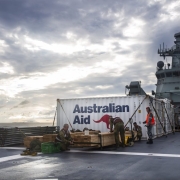Think about defence spending like this: when risks rise, so do insurance premiums
Australia’s strategic risk has increased significantly, and the government needs to increase its defence spending to match it.
Defence spending is the premium for Australia’s defence insurance policy—it underwrites Australia’s protection from external threats, with Australian Defence Force deployments as the insurance policy payout. And like all insurance policies, higher risk means higher premiums.
Australia’s eminent defence experts—actuaries of strategic risk—agree that higher defence premiums are needed. These include former defence minister Kim Beazley, former home affairs secretary Michael Pezzullo, former defence secretary Dennis Richardson and Sir Angus Houston.
Since January, Australia’s strategic environment has deteriorated even further due to greater external threats and greater uncertainty.
A primary reason for this is China’s demonstration of its capability and intent to directly threaten Australia with military force. In February, it deployed naval warships, including a state-of-the-art guided missile cruiser, to execute live-fire exercises around 340 nautical miles from Sydney. This effectively demonstrated China’s capability to directly threaten Australia’s heavily populated capital cities. It also provided insight into how China plans to use its growing military might.
And of course, Chinese President Xi Jinping has directed his armed forces to be ready to invade Taiwan from 2027, which is also the date that a former US chief of naval operations has set for the US Navy to be prepared for such an event. If Taiwan falls to China, an emboldened China will then have much greater leverage over other targets, such as South Korea, Japan and maybe even Australia. Much of Southeast Asia would hardly be in a position to resist China.
In recent months, major shifts have occurred in the defence posture of our closest allies. The US has made the Indo-Pacific as its ‘priority theater’ of operations, pushing Europe to the rear. Britain has upped its defence spending—its insurance premium—while reducing its Indo-Pacific deployments and renewing its focus on NATO and Europe. British defence spending will increase to 2.5 percent of GDP by 2027, with the aim of spending 3 percent by 2034.
Now Australia also needs to up its defence insurance premiums to match the increased strategic risk.
In the 2023 Defence Strategic Review (DSR), the most comprehensive reassessment of Australia’s defence posture and capability since the 1986 Dibb Review, experts independently assessed the capabilities Australia would need to defend itself. In effect, they calculated what Australia’s defence insurance premium needs to be in order to meet the enormous strategic risk that the country is facing.
The problem is that the actions recommended in the DSR are not being funded adequately or executed quickly enough to match Australia’s increased strategic needs. Houston, one of the lead authors of the DSR, has since argued that the government needs to spend 3 percent of GDP on defence to ensure that Australia’s new nuclear-powered submarines strengthen the ADF rather than displace other critical ADF capabilities.
It is essential to pay the right defence insurance premiums years in advance of trouble, because a defence insurance policy pays out not in dollars but in the form of capability such as air defence batteries to protect capital cities from enemy missile attack. Building effective capabilities takes time.
Australia is facing greater external threats, greater uncertainty and thus greater strategic risk. It must acquire the capability to defend itself in a more independent and self-reliant way. Defence spending is Australia’s national insurance policy. The higher the risk, the higher the premiums.




